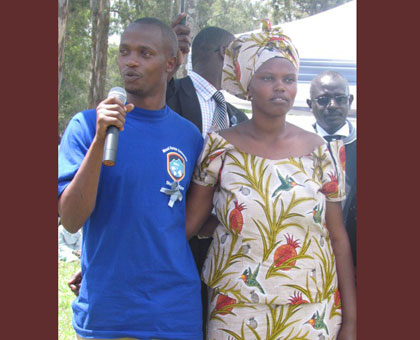The story of Frederic Simpunga is as heart-wrenching as it is soothing. It is perhaps unique and a-once-in-a-lifetime tale, the kind of real life occurrence that happens once in many years and that leaves many hearts filled with nostalgia and happiness at the same time.


The story of Frederic Simpunga is as heart-wrenching as it is soothing.
It is perhaps unique and a-once-in-a-lifetime tale, the kind of real life occurrence that happens once in many years and that leaves many hearts filled with nostalgia and happiness at the same time.
Simpunga is a young Genocide survivor who was born in the former Rusatira commune, now part of Huye District, Southern Province. He doesn’t know his exact age. Even his ‘official name’ is not what his parents bestowed upon him.
Unidentified toddler
When the 1994 Genocide against the Tutsi broke out some two decades ago, Simpunga was a boy aged between two and three.
As the killings intensified, Simpunga’s parents and relatives were killed. He miraculously survived. Today, the exact circumstances surrounding his survival remains unclear.
However, according to testimonies, when Interahamwe militia killed his mother who was carrying the toddler on her back, they threw them in a pit together with his father and bodies of other Tutsi who had been murdered.
His father, Yasson Rwagasore, who was still breathing but was taken for dead by the killers, is said to have managed to climb up from the pit, also bringing out the young Simpunga.
Unfortunately, he later met another bunch of killers who executed him. Again, Simpunga survived.
The story of the Rwagasore family and their fate came to be known through information gathered during the Gacaca trials.
Simpunga is said to have later been taken by ‘white volunteers’, who nearly ran over the loitering kid with their car. The ‘saviours’ then took the toddler to an orphanage in Sovu, on the outskirts of Huye town.
As his real name was not known, the toddler named Frederic Simpunga by his new caretakers.
Later, the young Simpunga found himself in a centre in Kigeme, now in Nyamagabe District.
Around 1996, a couple of "Good Samaritans” showed up at the orphanage and expressed willingness to take up one of the many orphans. Simpunga was thus driven to Mugano Sector in Nyamagabe District.
The search
As he grew up, Simpunga, who says he enjoyed the "sweet care and protection” of his foster parents, felt the need to seek his roots and what happened to his blood family.
But he knew there were a lot of challenges. What he remembered was only that his father was called Rwagasore and that they lived in Rusatira commune. That was about all. He had even forgotten his real name.
Simpunga says he started feeling the need to find out what happened to his family when he was about 10 years old, but feared to talk to his foster parents "because I didn’t want to offend them.”
"They gave me whatever I wanted; they took care of me as if I was their own son. Their love for me is incomparable. They are wonderful parents,” he says of the Louis Rutaganda’s family that raised him.
"However, despite the fact that I was lucky to grow up in a caring family, I always felt the urge to dig up for the whereabouts of my blood relatives. I always felt the need to find out what happened,” he adds.
For years, the teenager was distressed, something he says affected him psychologically and led to poor performance at school and had negative impact on his health.
"It was extremely unbearable,” he says of the distress that once saw him admitted to hospital for three weeks.
Miraculous find
Mid-last year, while a Senior Five student, Simpunga decided time had come to try and find out whether anyone in his family was still alive.
Together with a school friend, he travelled from Nyamagabe to the current Rusatira Sector, Huye District, in search of information about his relatives.
With the scanty information, the young Simpunga wandered through Rusatira not knowing where to go or who to ask. But his faith, determination, resilience and the support of his friend kept him optimistic.
"We were moving, narrating my story and my objective to whoever we met with the hope that we might come across someone helpful,” he says. "My friend helped me a lot because I would be overcome by emotions and wouldn’t talk.”
But the search became exhaustive and, in the first time, unpromising.
"We came across many people called Rwagasore and none seemed to match with my story,” he recalls.
It was while on the verge of abandoning the search that Simpunga and his colleague came across a man who gave them an account of one Rwagasore who was killed during the Genocide and whose last born was aged around three years. The old man gave the other name of Rwagasore as Yasson, according to Simpunga.
"I thought that young child could be me. I was convinced,” he says.
The man gave them a phone number of someone he said was Rwagasore’s surviving daughter.
They later talked, arranged a rendezvous and met. It was September 2013 and finally Simpunga had met his own sister.
The striking physical resemblance between the two, added to testimonies from residents and information that had been earlier gathered during the Gacaca proceedings in Rusatira, convinced Simpunga that he had unlocked the puzzle of his life.
He later learnt that his parents had named him Elie Kwizera, a name he says he wishes to regain.
Today, Simpunga says he is happy that he has found his blood relative who, he says, makes "one wonderful family” together with his foster family.


